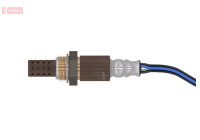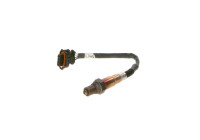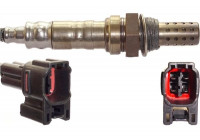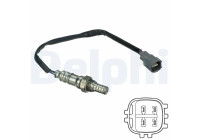Lambda sensor
The oxygen sensor is a sensor located in the exhaust of a car with a petrol engine. Its task is to measure the oxygen content in
the exhaust gases. Modern cars usually have two lambda sensors in the exhaust
system. The sensor mounted between the engine and the
catalytic converter measures the amount of oxygen. The sensor mounted after the catalyst measures
the efficiency of the catalyst. The catalytic converter needs the lambda sensor
to function properly. With the information sent by the lambda sensor, the
engine control unit (ECU) can compile the ideal air-to-fuel ratio. This optimal
ratio results in optimal combustion, resulting in fewer harmful exhaust
gases being exposed to the environment.
Faulty
lambda sensor symptoms
The oxygen sensor degrades over time. The life span of
a lambda sensor is difficult to state. It depends on several factors. If you
regularly drive short distances by car, the service life is often shorter. In
addition, other factors such as engine oil and poor quality gasoline have an
impact on the service life too. On average a lambda sensor should be changed at
around 100.000 miles to guarantee optimal operation.
Deposits from carbon, for example, can negatively
influence the operation of the oxygen sensor. A faulty lambda sensor can be
recognized by a number of symptoms. First of all, there is a good chance that
with a defective sensor, the Check Engine light will come on. Other symptoms may
include:
Increase in harmful exhaust gas emissions;
Increase in fuel consumption;
Poor performance or defective catalyst;
Car running rough (also with a warm
engine);
The vehicle feels laggy and is responding
slower than normal.
Do you recognize these symptoms? There is a chance
that the lambda sensor is due for a replacement. To find out if it is actually
a defective sensor, you can check the sensor with a code reader. A garage can
do this for you if you don't have a reader. Is the lambda sensor faulty? Then
it is important to replace it.
Lambda
sensor replacement
A lambda sensor can be easily replaced by yourself to
save money. How to replace the oxygen sensor exactly is difficult to describe,
because it differs per brand and type of car. But replacing a lambda sensor
works something like this;
Depending on where the lambda sensor is located; first, remove the upper motor cover or put the car on
axle stands . Use a spanner to
unscrew the lambda sensor. Is it too stuck? Then you can use
creeping oil like WD40 . Then follow the wire to the connector and disconnect it. Do you want to
replace the oxygen sensor that connects to the catalyst converter? Then it is
necessary to jack the car up with a
car jack . Then place axle stands under your
car for your safety. Have you removed the lambda sensor (s)? Always check this
for damage or contamination. If you are going to reassemble the new lambda,
first lubricate the thread with the grease or paste supplied. You can then put
the sensor back in and tighten it. Then re-attach the electrical wiring.
Find the
correct lambda sensor for your car
You can buy an oxygen sensor quickly and easily at
Winparts. Enter your number plate or car model on the site and the suitable
products for your car will be displayed. Only suitable parts will be shown so
you are sure they will fit your car. You can also contact us for other car
parts for the
exhaust system such as exhaust back box , downpipe , turbos and mounting parts.






















